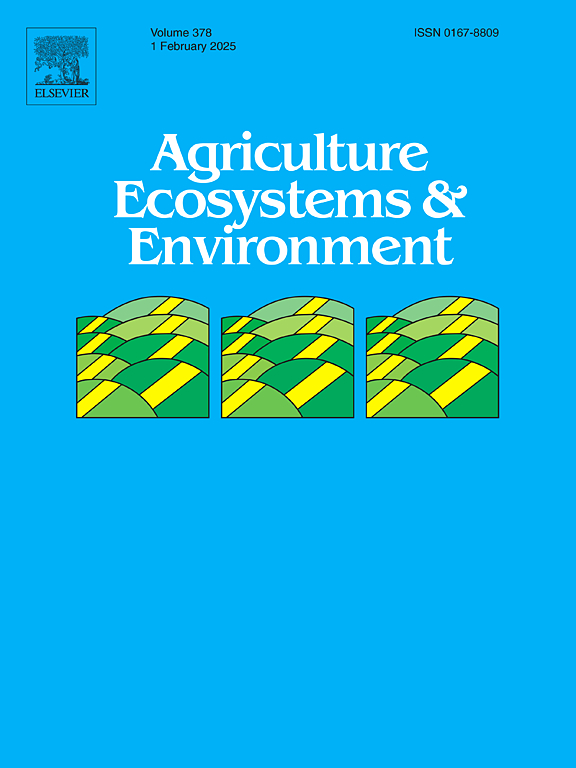Nutrient amendment promotes vegetation restoration and improves ecosystem carbon uptake capacity in a degraded grassland
IF 6
1区 农林科学
Q1 AGRICULTURE, MULTIDISCIPLINARY
引用次数: 0
Abstract
Approximately 49 % of global grasslands are degraded due to overgrazing and other forms of mismanagement, resulting in great reduction in vegetation productivity and carbon uptake capacity. Degradation-induced losses of soil nutrients, particularly nitrogen (N) and phosphorus (P), severely hinder the restoration of degraded grasslands in China. However, whether and how amendments of N and/or P promote vegetation recovery and improve carbon uptake capacity in degraded grasslands remain poorly understood. Here we present the results of a nutrient amendment experiment conducted in a degraded grassland in Inner Mongolia, where we evaluated the individual and joint effects of N and P amendments. We found that N amendment increased the aboveground net primary productivity (ANPP), belowground net primary productivity (BNPP), gross ecosystem carbon production (GEP), ecosystem respiration (ER), and net ecosystem exchange (NEE) by 66.9 %, 61.6 %, 27.3 %, 18.8 %, and 32.3 %, respectively, while NP co-amendment stimulated these variables by 104.7 %, 171.4 %, 48.7 %, 36.7 % and 56.8 %, respectively. In contrast, P amendment alone had little effect on these variables except for BNPP. We observed a distinct shift in the dominance of plant species, with short-stature, unproductive grasses being replaced by the originally-dominant, tall-stature, productive grasses. This shift significantly contributed to the improvement of ecosystem carbon uptake capacity. Moreover, we identified a synergistic interaction between N and P on GEP, ER, and NEE. Our results suggest that effective restoration strategies, such as the proper amendment of limiting nutrients, can help restore the large-scale, degraded grasslands and enhance their carbon uptake capacity in China.
养分修正促进退化草地植被恢复,提高生态系统碳吸收能力
全球约49% %的草地由于过度放牧和其他形式的管理不善而退化,导致植被生产力和碳吸收能力大大降低。退化导致的土壤养分损失,特别是氮和磷的流失,严重阻碍了中国退化草地的恢复。然而,N和/或P的修正是否以及如何促进退化草地的植被恢复和提高碳吸收能力仍然知之甚少。在此,我们介绍了在内蒙古退化草地上进行的养分修正实验的结果,在那里我们评估了N和P修正的单独和联合效应。我们发现N修正案增加了地上净初级生产力(友好),地下的净初级生产力(BNPP),生态系统碳生产总值(GEP),生态系统呼吸(ER),和净生态系统交换(NEE) 66.9 % 61.6 % 27.3 %, % 18.8和32.3 %,分别而NP co-amendment刺激这些变量 % 104.7,171.4 % 48.7 %,分别36.7 %和56.8 %。相比之下,单独P修正对除BNPP外的其他变量影响不大。我们观察到植物物种的优势地位发生了明显的变化,矮小的、非生产性的禾本科被原来占优势的、高大的、生产性的禾本科所取代。这种转变对生态系统碳吸收能力的提高有显著的促进作用。此外,我们还发现了氮和磷在GEP、ER和NEE上的协同作用。研究结果表明,适当修正限制养分等有效的恢复策略有助于中国大面积退化草地的恢复和碳吸收能力的增强。
本文章由计算机程序翻译,如有差异,请以英文原文为准。
求助全文
约1分钟内获得全文
求助全文
来源期刊

Agriculture, Ecosystems & Environment
环境科学-环境科学
CiteScore
11.70
自引率
9.10%
发文量
392
审稿时长
26 days
期刊介绍:
Agriculture, Ecosystems and Environment publishes scientific articles dealing with the interface between agroecosystems and the natural environment, specifically how agriculture influences the environment and how changes in that environment impact agroecosystems. Preference is given to papers from experimental and observational research at the field, system or landscape level, from studies that enhance our understanding of processes using data-based biophysical modelling, and papers that bridge scientific disciplines and integrate knowledge. All papers should be placed in an international or wide comparative context.
 求助内容:
求助内容: 应助结果提醒方式:
应助结果提醒方式:


